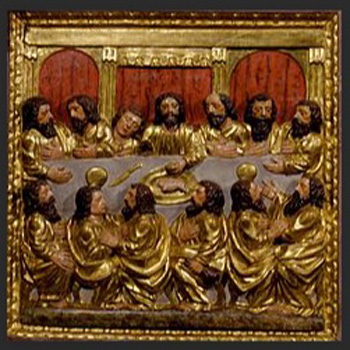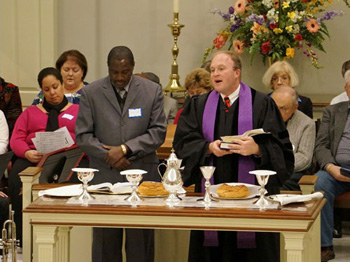Asuntos Tradicionalistas
 |
 |
 |
 |
 |
 |
 |
Olor a herejía en la misa de Pablo VI
Lumen gentium afirma que “el sacerdocio común de los fieles y el sacerdocio ministerial o jerárquico se ordenan el uno al otro… aunque difieren en esencia y no sólo en grado, cada uno de ellos en su modo particular es una participación en el único sacerdocio de Cristo.” (LG 10).
Pero también hay un significado heterodoxo subyacente en el Concilio Vaticano II (1962-1965), como se explica a continuación.
 La Misa es la reconstrucción de la cena pascual israelita del Antiguo Testamento (1), una ceremonia que conmemora el día en que Dios liberó a los israelitas de su esclavitud en Egipto La Pasión y Muerte del Mesías son la Nueva Pascua de la Nueva Alianza por el cual los fieles se salvan de la esclavitud del pecado y entran de nuevo en la tierra prometida, la Iglesia Católica que los conduce a la salvación eterna, el Cielo.
La Misa es la reconstrucción de la cena pascual israelita del Antiguo Testamento (1), una ceremonia que conmemora el día en que Dios liberó a los israelitas de su esclavitud en Egipto La Pasión y Muerte del Mesías son la Nueva Pascua de la Nueva Alianza por el cual los fieles se salvan de la esclavitud del pecado y entran de nuevo en la tierra prometida, la Iglesia Católica que los conduce a la salvación eterna, el Cielo.
Al consagrar el pan y el cáliz en la Última Cena y ordenar a Sus Apóstoles que repitieran este acto como memorial del Sacrificio de la Cruz, Nuestro Señor estableció la celebración de la Santa Misa como la Nueva Pascua.
Según la enseñanza tradicional de la Iglesia, el Sacrificio lo realiza un solo sacerdote.
Ahora, según el Concilio, este concepto ha cambiado: ahora es una asamblea de bautizados -presidida por un oficial eclesiástico calificado- que recuerda el nacimiento, vida, pasión, muerte y resurrección de Jesucristo.
La Misa se transformó. Ahora bien, se trata de una “comida” litúrgico-eucarística (I Cor 11, 21) en la que es la comunidad la que celebra. Hay una diferencia nuclear entre el sacerdocio común de los fieles Lumen gentium y la idea tradicional de que sólo un miembro del clero puede celebrar la Misa.
Tal impugnación se expresa en la Misa Reformada de Mons. Aníbal Bugnini y sus luteranos cartagineses, siguiendo la orientación de la Constitución “Sacrosanctum Concilium” sobre la liturgia (2). La Misa que de ella emana fue oficializada el 30 de noviembre de 1969 por Pablo VI en su discurso a una audiencia general en el Ordo Missae.
 Las ambigüedades en el texto de Sacrosanctum Concilium que están en la raíz de esta contestación fueron señaladas por el incomparable erudito conciliar Atila Sinke Guimarães:
Las ambigüedades en el texto de Sacrosanctum Concilium que están en la raíz de esta contestación fueron señaladas por el incomparable erudito conciliar Atila Sinke Guimarães:
“Una vez más, los resultados desastrosos son evidentes en cuanto a las ambigüedades de los textos de la Constitución Sacrosanctum Concilium, así como la reforma litúrgica y los documentos de 1969-1970 sobre la Misa”. (3).
En un cauteloso resumen de una línea, el teólogo franciscano progresista Buenaventura Kloppenburg reconoció que el Concilio de Juan XXIII y Pablo VI insinuó la idea de una igualdad eclesial entre el clero y los laicos: “La teología del laico parece haber puesto el teología del sacerdote en crisis”. Esta es una concepción notoriamente hipertrofiada del “sacerdocio común” de los fieles (4).
En 1993, el futuro cardenal alemán Walter Kasper confirmó esta interpretación progresista:
“La crisis del sacerdocio en la Iglesia católica tiene múltiples causas… En el fondo de esta crisis encontramos sin duda la acentuación de la eclesiología del pueblo de Dios, llevada a cabo por el mismo Concilio Vaticano II, que muestra claramente la realidad del común sacerdocio de todos los bautizados. Se ha dado un valor excesivo a la vocación específica de los laicos cristianos”. (5)
Esta deformación eclesiástica dio lugar a nuevos conceptos como el de la “concelebración con el pueblo”, que antes era considerado como espectador” sin derecho a la “participación plena, consciente y activa” (SC, 54, 48, 14).
De hecho, la liturgia ortodoxa, el silencio respetuoso, las formas dignas de actuar y de vestir, llevaron tendencialmente a la gente a comprender los misterios de la liturgia.
En el Misal Romano, la traducción del idioma latino y las numerosas notas explicativas proporcionan sólo una comprensión puramente intelectual de lo que estaba ocurriendo.
Al principio, un acólito, un laico -en representación del pueblo- respondía al celebrante (6); posteriormente se dieron respuestas participativas de toda la congregación, a las que se añadió una confesión colectiva de los laicos. (7)
Anteriormente, el sacerdote se interponía entre el crucifijo/tabernáculo y los laicos, afirmando simbólicamente que él era una autoridad acreditada y representante de Dios.
Hoy se dirige al pueblo, dando a entender que el primado sacerdotal es una dignidad sociológica y él es un mero representante de la comunidad.
El olor de la herejía
Así nació el diálogo continuo de las dos partes: los laicos leen el Evangelio, predican la homilía, distribuyen la comunión, se llevan la hostia a la boca como si fueran el sacerdote.
Las notas evocadoras, narrativas y conmemorativas del antiguo “banquete pascual” (SC) de antaño se acentuaron en la nueva liturgia, sugiriendo metódicamente que la Misa es, pura y simplemente, una comida conmemorativa religiosa cristiana.
En última instancia, la vaga comida espiritual sobre la acentuada "mesa de Dios" (SC, 51 – párrafo 605) sirvió para sellar "el encuentro con Cristo", sin referencia al carácter sacrificial de la Misa..
 En este contexto, no tiene sentido que el invitado principal del banquete esté de espaldas a los demás comensales; además, sería ilógico y extravagante que un invitado ayunara e inexplicable que disfrute de la comida de rodillas, de acuerdo con la hermosa tradición que precedió al Concilio Vaticano II.
En este contexto, no tiene sentido que el invitado principal del banquete esté de espaldas a los demás comensales; además, sería ilógico y extravagante que un invitado ayunara e inexplicable que disfrute de la comida de rodillas, de acuerdo con la hermosa tradición que precedió al Concilio Vaticano II.
Este proceso de protestantización de la Misa quedó claramente reflejado en los cinco datos que siguen:
En resumen, hoy el celebrante de la Misa se ha convertido en nada más que el ministro que forma parte del sacerdocio común.
Pero también hay un significado heterodoxo subyacente en el Concilio Vaticano II (1962-1965), como se explica a continuación.

La Última Cena se hizo en la fiesta
de la Pascua Judía
Al consagrar el pan y el cáliz en la Última Cena y ordenar a Sus Apóstoles que repitieran este acto como memorial del Sacrificio de la Cruz, Nuestro Señor estableció la celebración de la Santa Misa como la Nueva Pascua.
Según la enseñanza tradicional de la Iglesia, el Sacrificio lo realiza un solo sacerdote.
Ahora, según el Concilio, este concepto ha cambiado: ahora es una asamblea de bautizados -presidida por un oficial eclesiástico calificado- que recuerda el nacimiento, vida, pasión, muerte y resurrección de Jesucristo.
La Misa se transformó. Ahora bien, se trata de una “comida” litúrgico-eucarística (I Cor 11, 21) en la que es la comunidad la que celebra. Hay una diferencia nuclear entre el sacerdocio común de los fieles Lumen gentium y la idea tradicional de que sólo un miembro del clero puede celebrar la Misa.
Tal impugnación se expresa en la Misa Reformada de Mons. Aníbal Bugnini y sus luteranos cartagineses, siguiendo la orientación de la Constitución “Sacrosanctum Concilium” sobre la liturgia (2). La Misa que de ella emana fue oficializada el 30 de noviembre de 1969 por Pablo VI en su discurso a una audiencia general en el Ordo Missae.

Msgr. Annibale Bugnini con Paulo VI, los dos autores intelectuales de la Misa Nueva
“Una vez más, los resultados desastrosos son evidentes en cuanto a las ambigüedades de los textos de la Constitución Sacrosanctum Concilium, así como la reforma litúrgica y los documentos de 1969-1970 sobre la Misa”. (3).
En un cauteloso resumen de una línea, el teólogo franciscano progresista Buenaventura Kloppenburg reconoció que el Concilio de Juan XXIII y Pablo VI insinuó la idea de una igualdad eclesial entre el clero y los laicos: “La teología del laico parece haber puesto el teología del sacerdote en crisis”. Esta es una concepción notoriamente hipertrofiada del “sacerdocio común” de los fieles (4).
En 1993, el futuro cardenal alemán Walter Kasper confirmó esta interpretación progresista:
“La crisis del sacerdocio en la Iglesia católica tiene múltiples causas… En el fondo de esta crisis encontramos sin duda la acentuación de la eclesiología del pueblo de Dios, llevada a cabo por el mismo Concilio Vaticano II, que muestra claramente la realidad del común sacerdocio de todos los bautizados. Se ha dado un valor excesivo a la vocación específica de los laicos cristianos”. (5)
Esta deformación eclesiástica dio lugar a nuevos conceptos como el de la “concelebración con el pueblo”, que antes era considerado como espectador” sin derecho a la “participación plena, consciente y activa” (SC, 54, 48, 14).
De hecho, la liturgia ortodoxa, el silencio respetuoso, las formas dignas de actuar y de vestir, llevaron tendencialmente a la gente a comprender los misterios de la liturgia.
En el Misal Romano, la traducción del idioma latino y las numerosas notas explicativas proporcionan sólo una comprensión puramente intelectual de lo que estaba ocurriendo.
Al principio, un acólito, un laico -en representación del pueblo- respondía al celebrante (6); posteriormente se dieron respuestas participativas de toda la congregación, a las que se añadió una confesión colectiva de los laicos. (7)
Anteriormente, el sacerdote se interponía entre el crucifijo/tabernáculo y los laicos, afirmando simbólicamente que él era una autoridad acreditada y representante de Dios.
Hoy se dirige al pueblo, dando a entender que el primado sacerdotal es una dignidad sociológica y él es un mero representante de la comunidad.
El olor de la herejía
Así nació el diálogo continuo de las dos partes: los laicos leen el Evangelio, predican la homilía, distribuyen la comunión, se llevan la hostia a la boca como si fueran el sacerdote.
Las notas evocadoras, narrativas y conmemorativas del antiguo “banquete pascual” (SC) de antaño se acentuaron en la nueva liturgia, sugiriendo metódicamente que la Misa es, pura y simplemente, una comida conmemorativa religiosa cristiana.
En última instancia, la vaga comida espiritual sobre la acentuada "mesa de Dios" (SC, 51 – párrafo 605) sirvió para sellar "el encuentro con Cristo", sin referencia al carácter sacrificial de la Misa..

La Misa Novus Ordo se inspiró en el servicio protestante, arriba
Este proceso de protestantización de la Misa quedó claramente reflejado en los cinco datos que siguen:
- Prescindir del título “Santo” al referirse a los evangelistas, (8) en base a la Constitución Dogmática Dei Verbum (DV, 18);
- Las vestiduras del sacerdote se volvieron similares a las del “pastor” protestante;
- El pasado esplendor de la liturgia se empobreció en favor del espíritu igualitario protestante;
- De ahí vino el “fomentar las aclamaciones del pueblo” y los nuevos “gestos y posturas del cuerpo” igualitarios (SC, 30);
- Una reunión de carácter “mundano” (9), para hablar de eventos parroquiales y sociales, contrario a la vigilancia enseñada en el pasado (I Jn. 5:19; Ap. 21: 27) y avalada por eal bimilenaria Literatura moral católica.
En resumen, hoy el celebrante de la Misa se ha convertido en nada más que el ministro que forma parte del sacerdocio común.
- 1. "Es el sacrificio de la Pascua, en honor del Señor" (Ex. 12:27).
- 2. 3. 5. 9. Atila Sinke Guimaraes, En las aguas turbias del Concilio Vaticano II, São Paulo: Scor Editora Tecci, 1999, vol. yo, págs. 184-186, 249, 305, 262.
- 4. La Eclesiología del Vaticano II, Petrópolis: Vozes, 1971, p. 53.
- 6. 7. 8. Arzobispo Beda Keckeisen, OSB. Misal Cotidiano, Salvador: Tipografia Beneditina Ltda., 1949, pp. 1, 3, 29.
Publicado el 3 de diciembre de 2022
______________________
______________________
 Volume I |
 Volume II |
 Volume III |
 Volume IV |
 Volume V |
 Volume VI |
 Volume VII |
 Volume VIII |
 Volume IX |
 Volume X |
 Volume XI |
 Special Edition |



